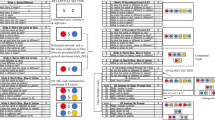Abstract
Two multiple baseline designs were conducted across participants to determine if the promoting the emergence of advanced knowledge (PEAK) equivalence module was an effective tool in teaching adults with autism relationships between stimuli. More specifically, a transitivity program utilizing the gustatory sensory modality was implemented. Stimuli were selected and probed initially preceding the training. First, gustatory stimuli to a visual picture were trained. Then, a visual picture to a spoken word was trained. Finally, once mastery criterion was reached, each participant’s responding was tested to determine whether there were derived relations following training. Results showed that all three participants reached mastery criterion in training sessions and were able to derive new relations without direct training.



Similar content being viewed by others
References
Buescher, A. V., Cidav, Z., Knapp, M., & Mandell, D. S. (2014). Costs of autism spectrum disorders in the United Kingdom and the United States. JAMA Pediatrics, 168(8), 721–728.
Cooper, J. O., Heron, T. E., & Heward, W. L. (1987). Applied behavior analysis. Columbus: Merrill Pub.
Dixon, M. R. (2015). Promoting the emergence of advanced knowledge relational training system: equivalence module. Carbondale: Shawnee Behavioral Press.
Dixon, M. R., Belisle, J., Stanley, C. R., Daar, J. H., & Williams, L. A. (2016a). Derived equivalence relations of geometry skills in students with autism: an application of the PEAK-E curriculum. Analysis of Verbal Behavior. doi:10.1007/s40616-016-0051-9.
Dixon, M. R., Belisle, J., Whiting, S. W., & Rowsey, K. E. (2014a). Normative sample of the PEAK relational training system: direct training module and subsequent comparisons to individuals with autism. Research in Autism Spectrum Disorders, 8(11), 1597–1606. doi:10.1016/j.rasd.2014.07.020.
Dixon, M. R., Speelman, R., Rowsey, K., & Belisle, J. (2016b). Derived rule-following and transformations of stimulus functions in a children’s game: an application of PEAK-E with children with developmental disabilities. Journal of Contextual Behavioral Science, 5, 186–192. doi:10.1016/j.jcbs.2016.05.002.
Dixon, M. R., Whiting, S. W., Rowsey, K., & Belisle, J. (2014b). Assessing the relationship between intelligence and the PEAK relational training system. Research in Autism Spectrum Disorders, 8(9), 1208–1213. doi:10.1016/j.rasd.2014.05.005.
Fienup, D. M., & Dixon, M. R. (2006). Acquisition and maintenance of visual-visual and visual-olfactory equivalence classes. European Journal of Behavior Analysis, 7, 87–98.
Hayes, L. J., Tilley, K., & Hayes, S. C. (1988). Extending equivalence class membership to gustatory stimuli. The Psychological Record, 38(4), 473.
McKeel, A. N., Dixon, M. R., Daar, J. H., Rowsey, K. E., & Szekely, S. (2015). Evaluating the efficacy of the PEAK relational training system using a randomized controlled trial of children with autism. Journal of Behavioral Education, 24(2), 230–241. doi:10.1007/s10864-015-9219-y.
National Autism Center: National Standards Project (2015). Retrieved March 9, 2016, from http://www.nationalautismcenter.org/national-standards-project/results-reports/
Office of the Surgeon General (OSG). (2000). Mental health: a report of the surgeon general. Retrieved 16 February 2016 from http://www.surgeongeneral.gov/library/mentalhealth
O'Neill, M., & Jones, R. S. (1997). Sensory-perceptual abnormalities in autism: a case for more research? Journal of Autism and Developmental Disorders, 27(3), 283–293. doi:10.4236/ojpsych.2012.21005.
Rehfeldt, R. A. (2011). Toward a technology of derived stimulus relations: an analysis of articles published in the Journal of Applied Behavior Analysis, 1992–2009. Journal of Applied Behavior Analysis, 44(1), 109–119. doi:10.1901/jaba.2011.44-109.
Rose, J. C., Souza, D. G., & Hanna, E. S. (1996). Teaching reading and spelling: exclusion and stimulus equivalence. Journal of Applied Behavior Analysis, 29(4), 451–469. doi:10.1901/jaba.1996.29-451.
Rowsey, K. E., Belisle, J., & Dixon, M. R. (2015). Principal component analysis of the PEAK relational training system. Journal of Developmental and Physical Disabilities, 27(1), 15–23. doi:10.1007/s10882-014-9398-9.
Sidman, M. (1971). Reading and auditory-visual equivalences. Journal of Speech and Hearing Research, 14, 5–13. doi:10.1044/jshr.1401.05.
Sidman, M. (1994). Equivalence relations and behavior: a research story. Boston: Authors Cooperative.
Smith, T. (2001). Discrete trial training in the treatment of autism. Focus on autism and other developmental disabilities, 16(2), 86–92. doi:10.1177/108835760101600204.
Toussaint, K., & Tiger, J. T. (2010). Teaching early braille literacy skills within a stimulus equivalence paradigm to children with degenerative visual impairments. Journal of Applied Behavior Analysis, 43, 181–194. doi:10.1901/jaba.2010.43-181.
Author information
Authors and Affiliations
Corresponding author
Ethics declarations
Conflict of Interest
The authors declare that they have no conflict of interest.
Funding
This study was not funded.
Ethical Approval
All applicable international, national, and/or institutional guidelines for the care and use of animals were followed. All procedures performed in studies involving human participants were in accordance with the ethical standards of the institutional and/or national research committee and with the 1964 Helsinki Declaration and its later amendments or comparable ethical standards. This article does not contain any studies with animals performed by any of the authors.
Informed Consent
Informed consent was obtained from all individual participants included in the study.
Additional information
1. This study shows that adults in group home settings can learn complex skills related to verbal behavior via evidence-based teaching strategies.
2. Due to the short implementation time, this study gives implications for adults to utilize evidence-based curriculum on a wide scale to teach communication skills.
3. This study gives implications to the tool that was used, PEAK-E, including that it is practical to use in an applied setting.
4. This study gives implications to current practitioners to seek evidence-based assessments and curriculum when designing verbal behavior-based programs.
Rights and permissions
About this article
Cite this article
McKeel, A., Matas, J. Utilizing PEAK Relational Training System to Teach Visual, Gustatory, and Auditory Relations to Adults with Developmental Disabilities. Behav Analysis Practice 10, 252–260 (2017). https://doi.org/10.1007/s40617-017-0194-8
Published:
Issue Date:
DOI: https://doi.org/10.1007/s40617-017-0194-8




